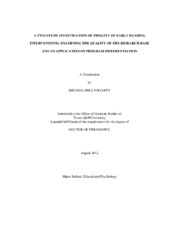| dc.description.abstract | This research consisted of two studies. The purpose of the first study was to examine the presence and quality of fidelity of implementation as reported in recent early reading intervention research. A comprehensive search of kindergarten through third-grade reading interventions published between the years 2005 and 2011 was conducted. Articles that met the inclusion search criteria were analyzed according to fidelity dimensions. Findings from the first study indicated an increase in fidelity reporting from 2001 to 2005. Few articles, however, analyzed the relationship between fidelity of implementation and student outcomes. While there has been an increase of early reading intervention studies reporting fidelity, there is a lack of studies reporting fidelity in relation to student outcomes. Many studies are reporting multiple dimensions of fidelity, but few studies assess the program differentiation dimension.
The second study was an exploratory study focused on the fidelity dimension of program differentiation as applied to two early reading interventions from an experimental study. A fidelity observation instrument was created using evidence-based reading practices. The fidelity observation instrument was then used to evaluate instructional practices, teacher responsiveness, and student engagement of an experimental and comparison reading intervention at three time points to examine program differentiation. Latent constructs were created using exploratory factor analysis and were then used to compute an effect size called the achieved relative strength index, which is the difference between two experimental conditions. Findings from the exploratory factor analysis in the second study indicated items loaded onto three latent constructs: (a) instructional practices, (b) teacher responsiveness, and (c) student engagement. The instructional practice achieved relative strength index effect size was large for the experimental group. The achieved relative strength index effect size for both teacher responsiveness and student engagement was small, indicating little difference between the two conditions. The second study in this research endeavor addressed that gap by applying the achieved relative strength index effect size to an early reading intervention study and demonstrating one way to capture program differentiation. Finally, implications for future research were addressed as part of the study. | en |


